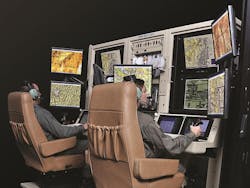Air Force awards $21.1 million to General Atomics for Predator and Reaper UAV crew simulators
WRIGHT-PATTERSON AFB, Ohio, 18 June 2015. Flight simulation experts at General Atomics Corp. will provide the U.S. Air Force with UAV crew simulators and spare parts to help combat drone pilots practice their skills and rehearse missions.
Officials of the Air Force Life Cycle Management Center at Wright-Patterson Air Force Base, Ohio, announced a $21.1 million order Tuesday to the General Atomics Aeronautical Systems segment in Poway, Calif., to provide Predator Mission Aircrew Training Systems (PMATS).
The General Atomics PMATS is a sophisticated flight simulator that reproduces the aircrew ground stations of MQ-1 Predator and Predator B/MQ-9 Reaper unmanned aerial vehicle (UAV) pilots and sensor operators.
The Predator and Reaper flight simulators enable students to master the art of flying and operating the Predator and Reaper UAVs using actual flight hardware. With PMATS, the level of realism between simulated exercises and real-world operations is transparent. The system is currently in operation with the U.S. Air Force.
PMATS consists of a form, fit, and function user interface for the pilot and sensor operator stations and uses General Atomics Ground Control Station (GCS) hardware.
Related: The next generation of simulation-based training
The General Atomics equipment is integrated with the L-3 training system hardware and software to produce high-fidelity training that models the General Atomics UAV systems, sensors, and weapons.
These flight simulators are for initial qualification and mission training, including emergency and abnormal procedures training. PMATS is integrated with instructional systems, including an instructor operator station (IOS) that supports crew training, monitoring, and evaluation.
The system provides training in stand-alone and local-area-network modes to enable either one pilot or several pilots to train together in the same building or vicinity. PMATS also can participate in the Air Force's Distributed Mission Operations (DMO) portal, enabling Predator and Reaper air crews to train together with other DMO-compliant platforms.
PMATS is available in a standalone configuration, which provides a dedicated training system; a PMATS appended system that uses an operational ground-control station for training and mission operations; and a PMATS lite system that provides low-cost, high-fidelity, dedicated training. All three systems use actual Predator and Reaper hardware and software and L-3's Blue Box High-definition (HD) training environment.
On this order General Atomics will do the work in Poway, Calif., and should be finished by January 2018. For more information contact General Atomics Aeronautical Systems online at www.ga-asi.com, or the Air Force Life Cycle Management Center at www.wpafb.af.mil/aflcmc.

